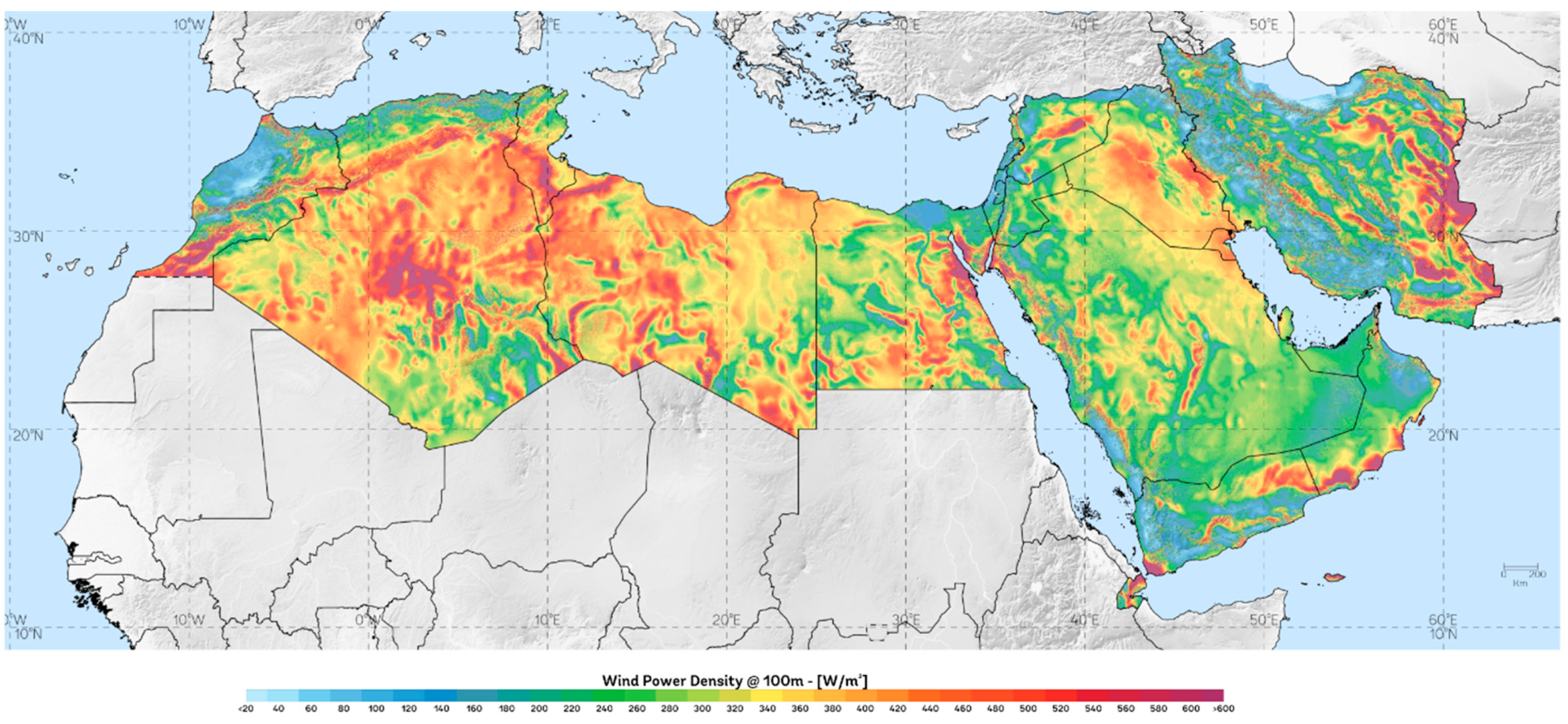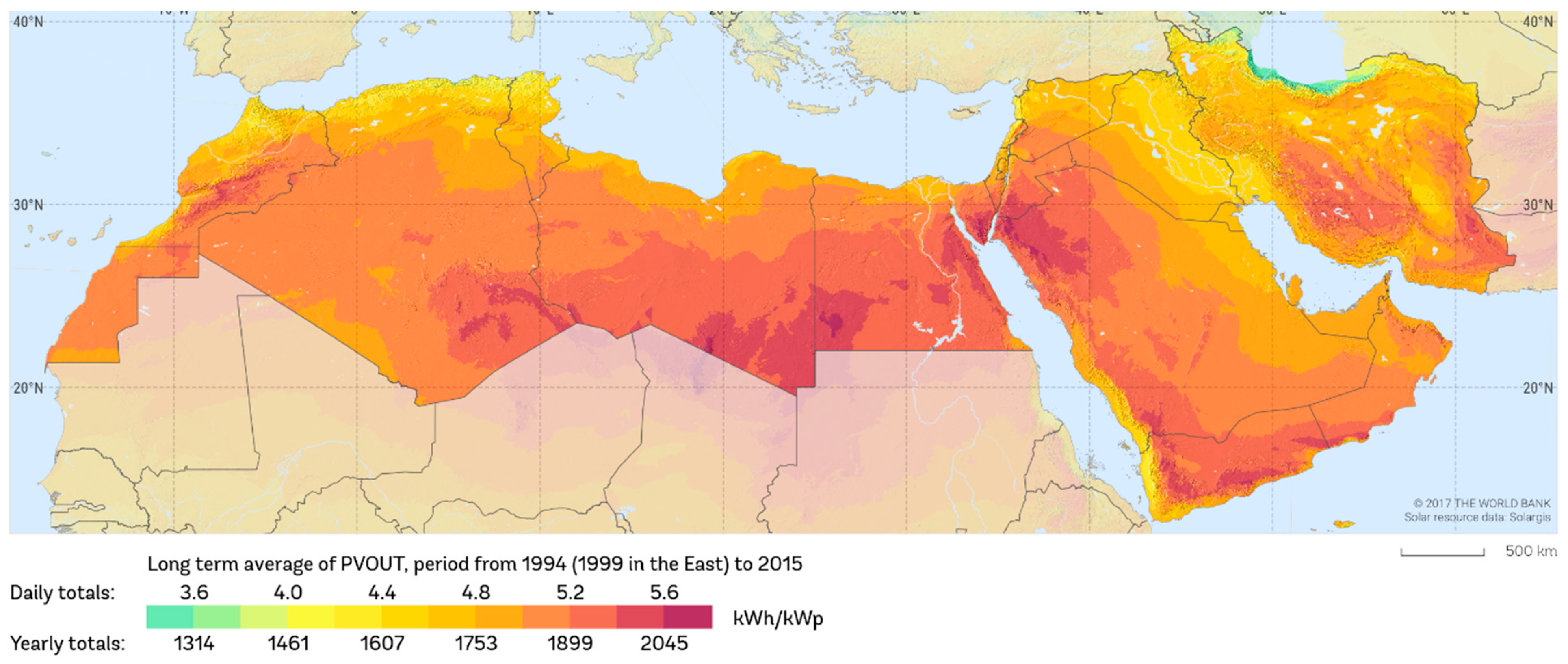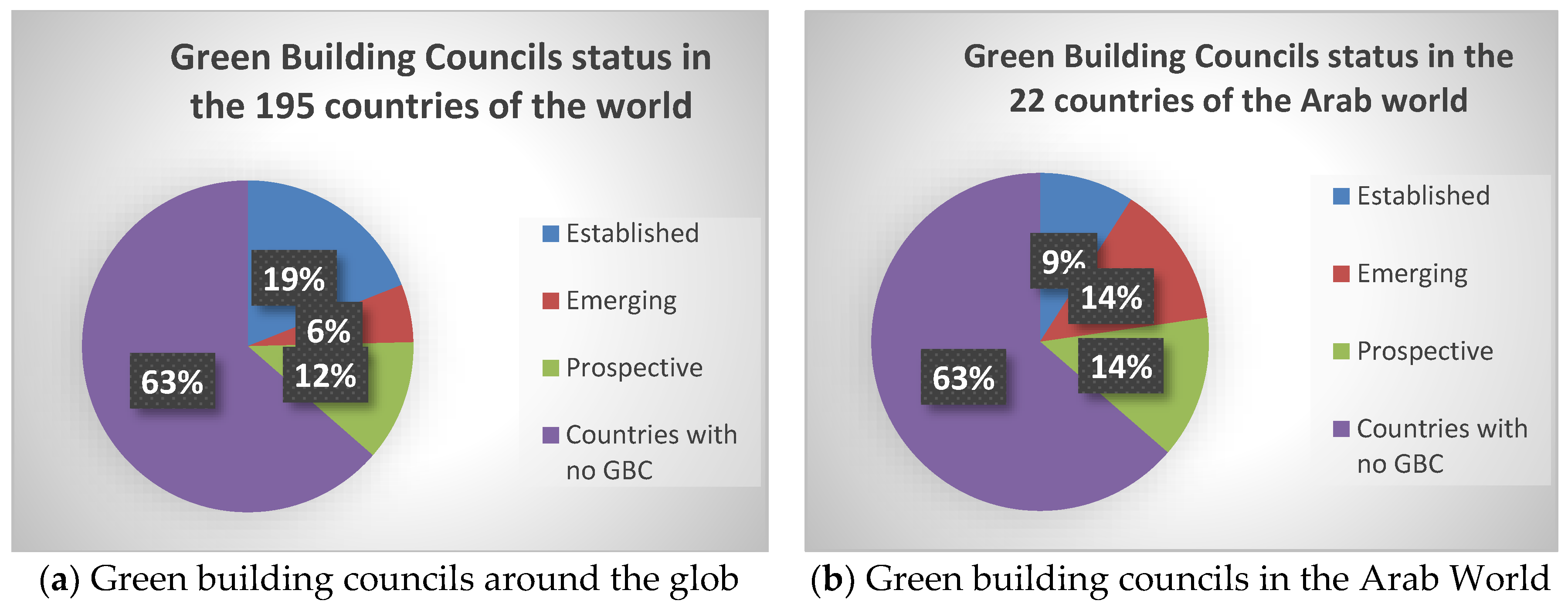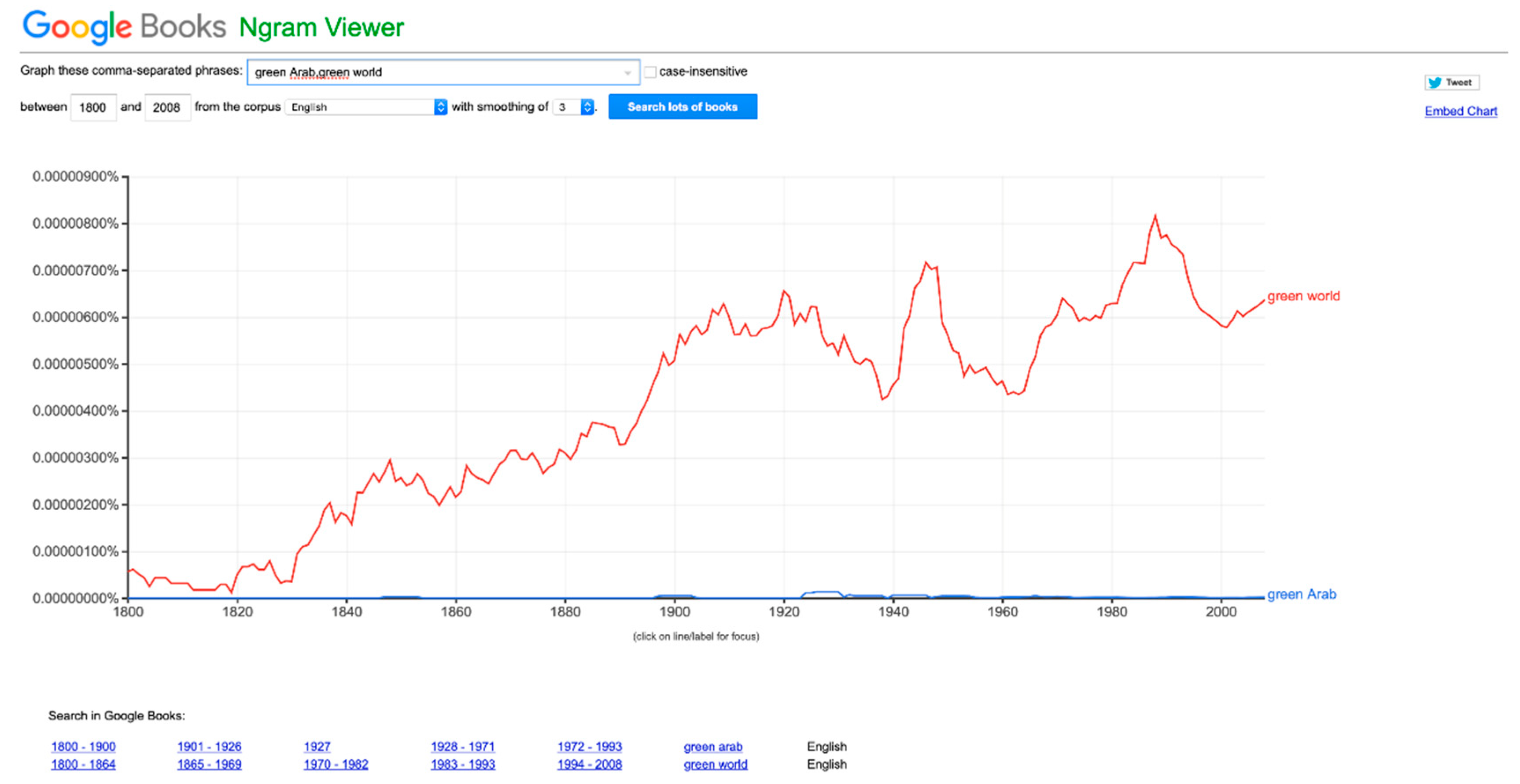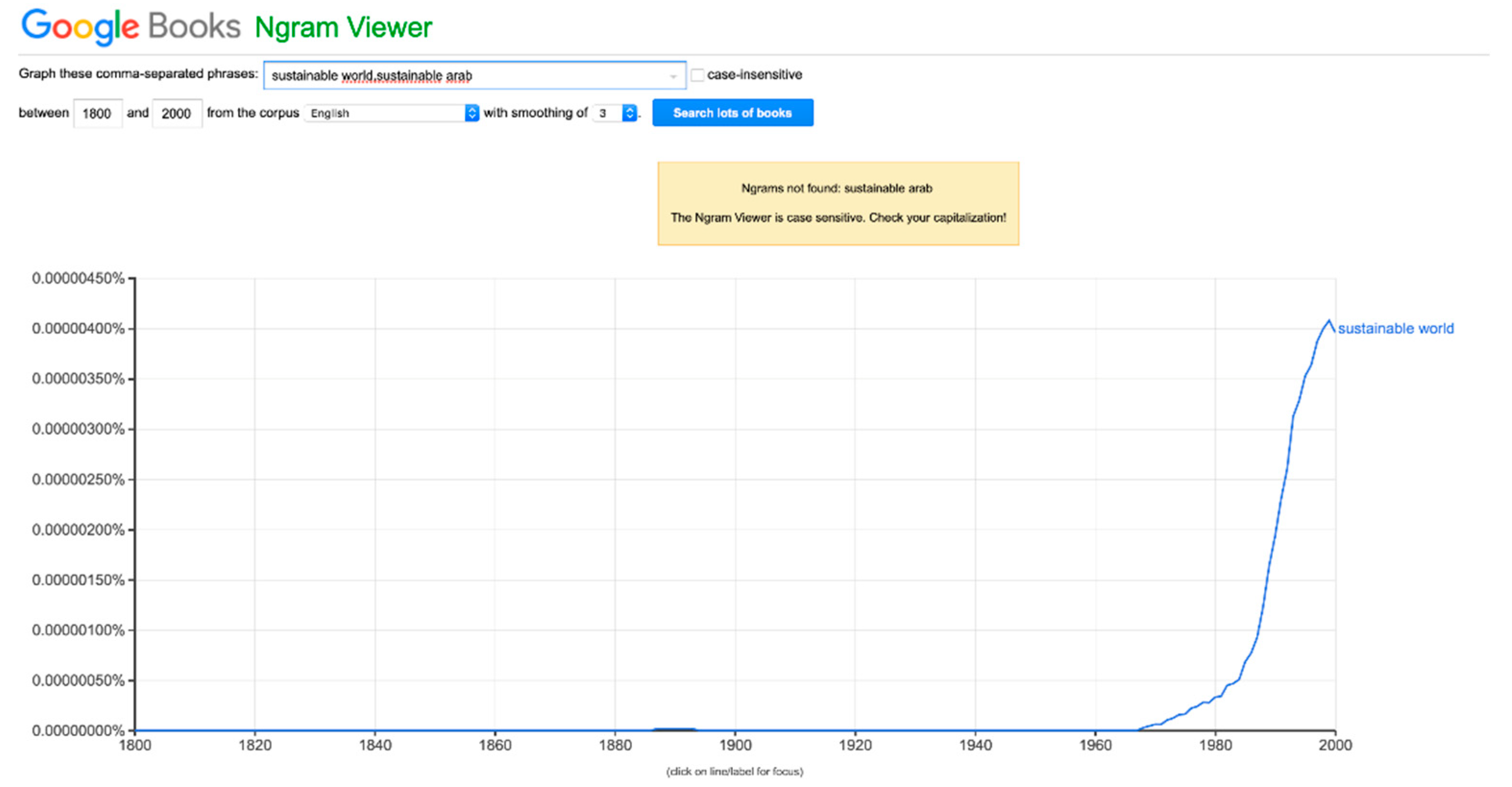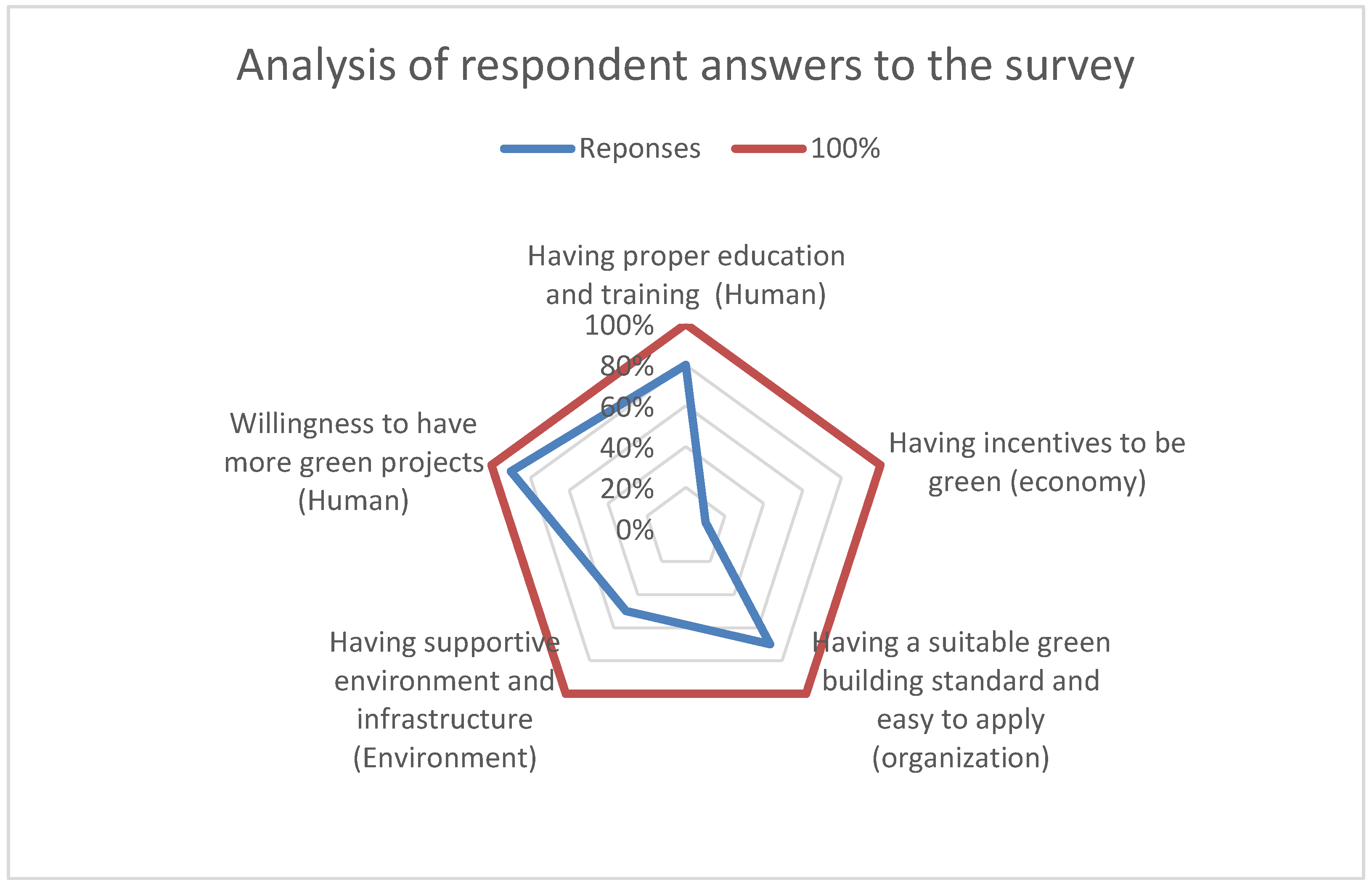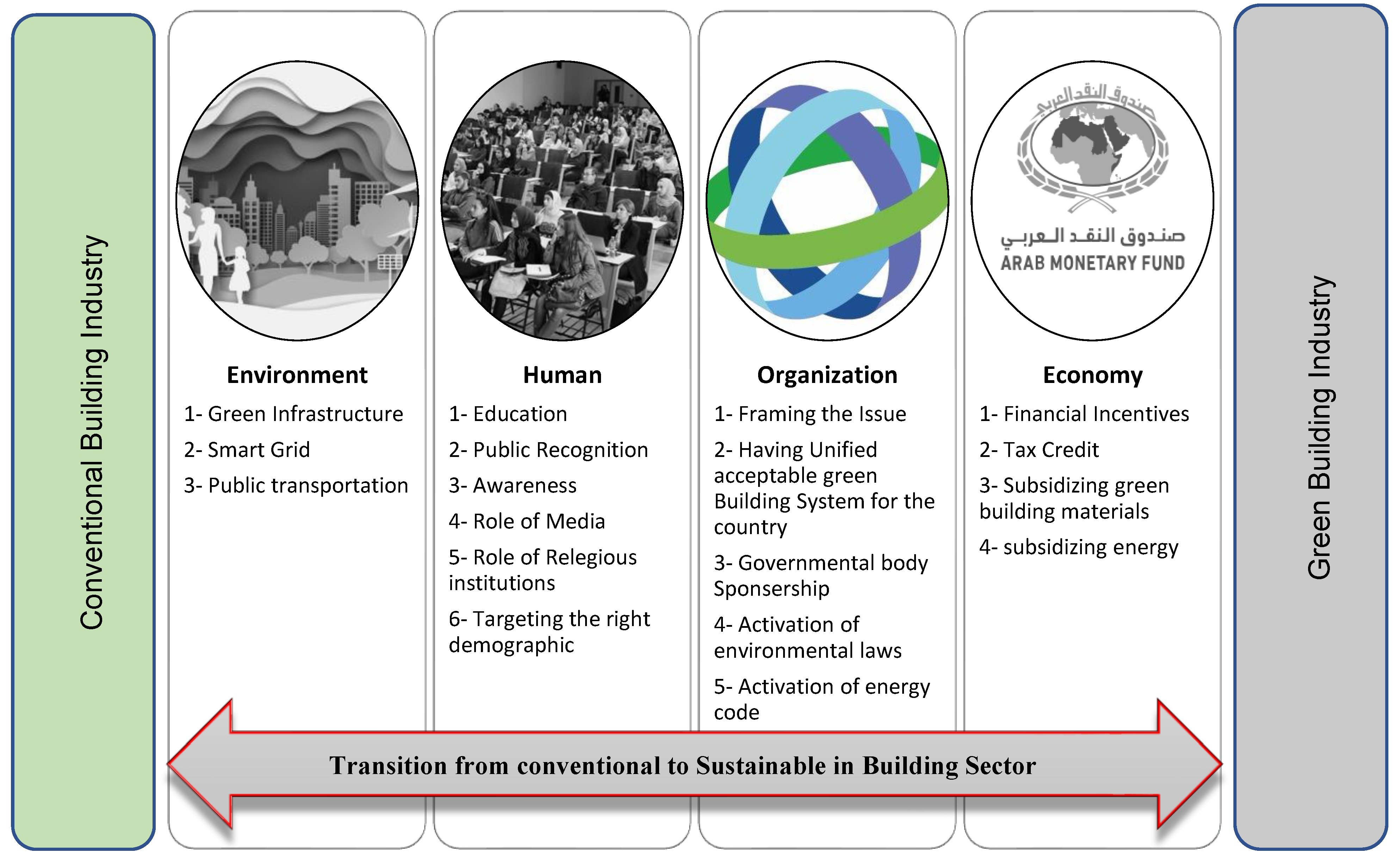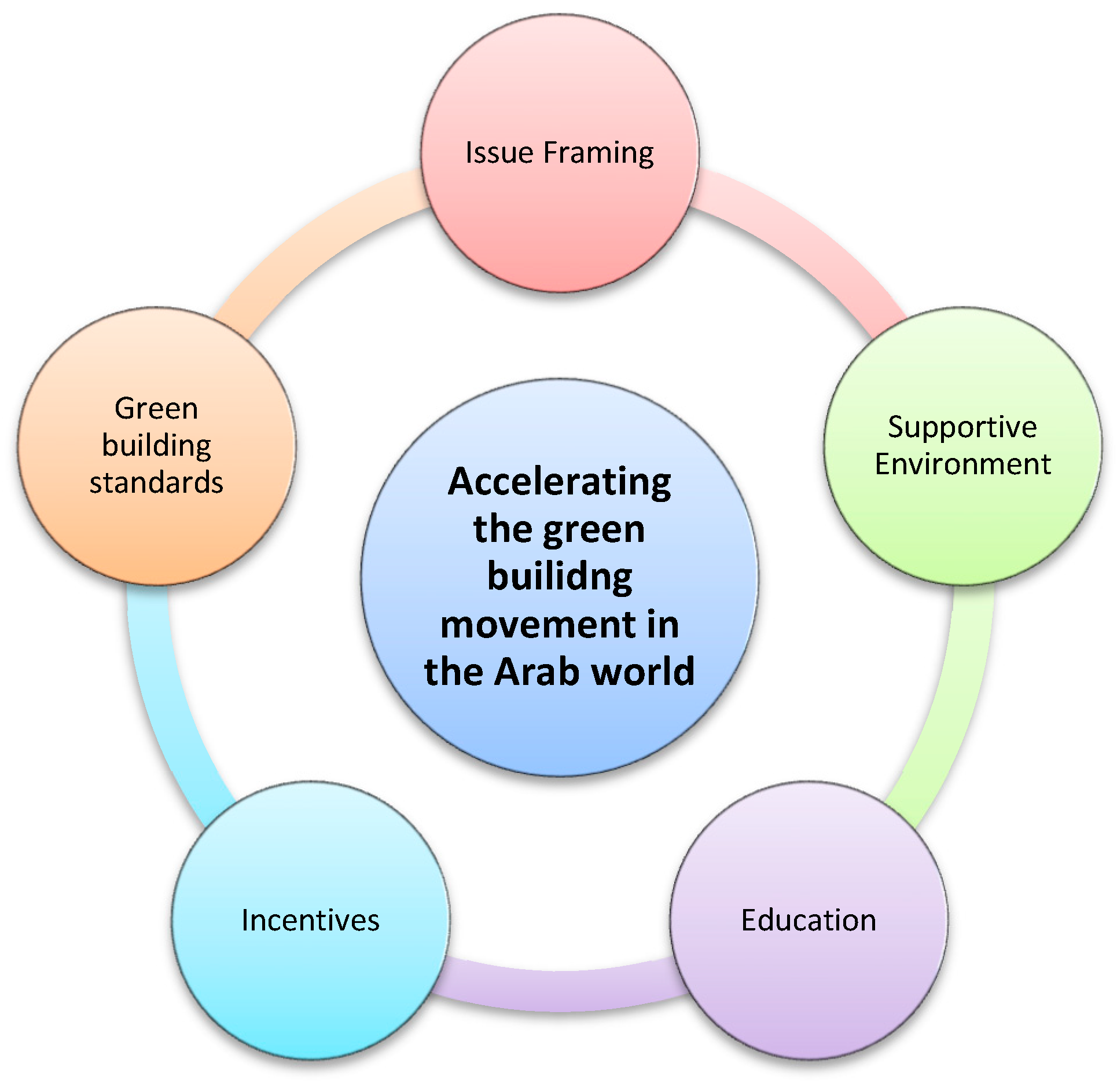1. Introduction
In 1983, the United Nations chose former Norwegian prime minister Gro Harlem Brundtland to lead the new World Commission on Environment and Development. The main objective was to define a way of development that targets the human prosperity towards a better quality of life while having minimum impact on the ecology [
1,
2]. Four years later, the “Brundtland Commission” released its final report “Our Common Future”. It defines sustainable development as “development that meets the needs of the present without compromising the ability of future generations to meet their own needs” [
1]. The Commission successfully included the environmental, social, and economic dimensions to be unified on the world’s development agenda.
As a result of this new definition, adopting the three dimensions of sustainability were incorporated in many fields and industries, such as planning, architecture, business development, accounting, agriculture, and design. The building industry, with its direct impact on cities and urban development, has gone through this transition gradually since Brundtland’s definition of sustainable development. In 1990, the world’s first sustainability assessment method for buildings was founded by the Building Research Establishment in UK. Three years later, the US Green Building Council was established in 1993 to promote sustainability in design, construction, and operation in the building industry in the United States of America, however United States Green Building Council (USGBC) developed the first version of Leadership in Energy and Environmental Design in 1998 [
3].
During these three decades, many sustainability standards, codes, and rating systems were created and used to help in designing, constructing, maintaining, rating, and labeling buildings with attaining the principles of sustainability. Developing countries are experiencing exponential growth in the urban built environment, presenting a great opportunity in making the design and construction practices in these countries more sustainable through green building guidelines [
4]. However, many of the developing countries are still dominated by conventional non-sustainable building industries. This might reflect many challenges and obstacles that prevent such a paradigm shift in countries that are in dire need for such transition.
Given the tremendous benefits and impacts of a green building industry on the built environment, it has become a necessity for many Arab countries to improve the quality of their built environment through transforming their construction industry from conventional to green or sustainable. Green buildings follow principles and guidelines to reduce the heat island effect, save energy, water, and natural resources, and reduce the greenhouse gas emissions. Also, a green building industry would help the economy by creating more sustainable jobs and identifying new ways for potential social sustainability in the built environment [
5].
The Arab world consists of 22 countries. Arab countries spread from the Arabian Peninsula bordered with Turkey to the north and spread through North Africa. Although they speak the Arabic language and share a lot of social and cultural values that are originally driven by Islamic traditions, there are many factors that distinguish each country from another socially, economically, and environmentally. For instance, Golf Cooperation Council countries are oil producers, and known by their higher standard of living when they are compared with other countries such as Jordon or Egypt. The Arab region is characterized by demographic, socioeconomic, and political diversity, and as of 2016, the total population of all Arab countries is 423 million [
6]. Also, Arab countries are very diverse in water security, energy consumption per capita, ecological foot print per capita, environmental quality, and available resources. However, due to the geographical location, Arab countries have very high potential of renewable energy resources such as solar energy and wind energy.
Figure 1 and
Figure 2 show wind power density and photovoltaic power potentials of the Arab world.
In the Arab World, there is a cohort of academics and researchers who wonder about the challenges and obstacles that hinder the spread of green building movement in the region. They argued various social, economic, and environmental reasons; according to Elfiky, green building initiatives are very rare with slow movement towards green building practices in Egypt [
7]. Also, people in Egypt are resistant to green buildings because they lack the proper education and awareness of green technology, and they do not want to invest in such things that they believe they are not able to maintain; “the main challenges are education and affordability” [
8]. Mosly found that lack of skilled workers, unsupportive government policies, and regulations are the most significant barriers to the spreading of green buildings in Saudi Arabia [
9].
1.1. Green Building Movement in the Arab World, What Has Been Done So Far?
Like other non-industrialized countries, the green building movement was sparked by establishment of green building councils. Whether these councils were initiated by governments or non-profit organizations, they were the first educational source to teach building professionals about sustainability in the built environment. The second source is higher education; as sustainability found its roots in the curriculum of higher education degrees, a massive scholarship activity has emerged by planners, architects, engineers, and designers who motivate a new generation of professionals towards a green industry.
While the green building movement gained momentum with the establishment of local green building councils in most of the countries, as of today, of the world’s 195 countries, the number of green building Councils did not exceed 72 in 72 countries; 37 of them are already established, 11 are emerging, 23 are prospective, and 1 was created as partnership (World Green Building Council website). In the Arab world, only two were established in Jordon and United Arab Emirates—three are prospective in Egypt, Bahrain, and Morocco—and another three are considered emerging in Kuwait, Lebanon, and Qatar. This is aligning the Arab region with the rest of the world in terms of the percentage of number of countries with no green building councils (see
Figure 3b). Further, 63% of the Arab countries do not have green building councils, however this percentage leaves Arab countries in a better situation than the world. The 63% of the world’s countries are varied in terms of climate, available resources, and culture, however, the 63% of the Arab countries that do not have green building councils share nearly similar climate conditions, available resources, and culture with the rest of Arab countries that have established green building councils. The questions are; do we need more green building councils in the Arab world? What prevents well-established green building councils such as Estidama and global sustainability assessment system (GSAS) or ARZ from being used across the Arab nations?
1.2. Green Building Rating Systems
The only active green building rating systems in the Arab world are Pearl (Estidama) in United Arab Emirates, GSAS in Qatar, and ARZ in Lebanon, see
Table 1. [
10], however the number of buildings that received certifications from these rating systems are less than 100 buildings. United Arab Emirates and Qatar are spearheading the sustainability trend in the region, with the highest share of green buildings in the Middle East and North Africa. There are about 1200 green buildings in the Middle East and North Africa MENA region that have a leadership in energy and environmental design (LEED) certification. Of these buildings, 65% (802) are located in the UAE. Qatar is ranked second on the list, with 173 green buildings, followed by Saudi Arabia (145), Lebanon (25), and Egypt (22) [
11].
2. Methods
A mixed-methods research design was used to elucidate the challenges and key factors of adopting sustainability in the building industry of the Arab world; literature review was conducted to explore the current status of the Arab building industry with regard to the global sustainability movement, and this included a critical review of “sustainability” and “green design” as keywords in architecture and engineering higher education across the region. In addition, a survey was conducted to collect feedback from building professionals. A questionnaire as an effective tool to survey professional feedback [
12] was designed to target various areas in the design and construction of sustainable buildings. The responses were analyzed to reveal the challenges and key factors that could support and accelerate the green building movement in the Arab world.
2.1. Sustainability of the Arab World in the Literature
A search of keywords “Arab, sustainable, Building, design, construction,” on google scholar was performed on 7 June 2019 and gave 20,100 results that included journal articles and books. The search was operated to reveal the articles and books that contain all the five keywords collectively in the text. At the same time, another search was operated excluding the word “Arab” from the keywords, just searching the four words “sustainable, Building, design, construction”, producing 1,750,000 items including books and journal articles.
This simple search on google scholar, as the most powerful search engine for scholarship activities, indicates that the scholarship activities related to sustainable building design and construction in the Arab world is a very small fraction, at almost 1% of the global effort. Also, a simple search was done on Google Ngram database to identify the existence of 4 terms in the books of the database “green world”, “green Arab”, “sustainable world”, and “sustainable Arab”. As shown in
Figure 4 and
Figure 5, “green Arab” and “sustainable Arab” are absent from the graph because these terms were rarely mentioned in the books from the 1800s until today; on the other hand, “green world” and “sustainable world” show a noticeably higher frequency since the 1960s.
A study of existence of sustainability in the curricula of the architecture schools of the Arab region found that there are only 17 courses that address sustainability and environmental consciousness paradigm in their content; of these, there are 12 courses offered within the core curriculum, while 5 courses are offered as electives [
13]. Philosophy statements and objectives of programs refer to relating design artifacts to the natural environment. However, it was noticed that this is not reflected in most of the programs, course contents, or even in elective offerings. Although it was expected that the more technical oriented programs under engineering colleges would have more offerings addressing ecological principles of sustainable design than other programs, the analysis revealed the opposite [
13].
In 2012, interior design lecturers and professors were invited to participate in a survey on their university’s interior architecture curricula. The study showed that all interior design programs currently do not teach sustainability within their curricula, and there are some obstacles in teaching sustainability [
14]. Although interest in sustainable design teaching and learning started more than 20 years ago at both post graduate and undergraduate level in Egypt, ecological illiteracy persists in architecture education. There is a large gap between what our schools of architecture offer, what the regulations currently specify, and what the market demands [
15].
2.2. Survey of AEC Professionals
In February 2019, a questionnaire was designed and launched to reveal and classify the challenges of green building industry into four categories; environmental, social, economic, and organizational. The questionnaire was sent to building professionals who participated in green projects across the region. At the beginning, the online link to the questionnaire,
https://forms.gle/Lacq4RDUG1GZLRs19, was sent to a network of architects and engineers in Egypt, Saudi Arabia, United Arab Emirates, and Jordan; then, the distribution of the questionnaire extended to Algeria, Morocco, Kuwait, and Qatar. Although the questionnaire was distributed effectively in many countries across the Arab world, the number of respondents was not as expected. By June 2019, 35 responses were collected from professionals who worked on projects in Egypt, Saudi Arabia, United Arab Emirates, Jordon, and Qatar.
Table 2 shows the characteristics of the sample of respondents.
3. Results and Analysis
3.1. Results of the Survey
The questionnaire included questions about the difficulties faced by professionals when working in a green project for the first time, the differences between green projects and conventional projects in terms of skills they needed in each project [
16], and the sufficiency of education and training they had to enable them to work successfully in green projects. A sample of these questions is as follows; did you find the knowledge you have learned from your education sufficient to be able to do your tasks in this project? What areas of knowledge or training do you think, if received, would have made your performance better in this project? Based on your experience in this project, what do you think about the prospect of green certified buildings in your country? In your opinion, after your experience in this project, what are the challenges you think will hinder the green building movement in your country? Most of the questions included multiple choices. However, the respondents were given a chance to explain their experience after each question; this mix between the multiple choice and open-ended questions resulted in a better understanding of the challenges and possible solutions in each country.
The challenges were classified into four categories related to the environment, humans, organizations, and the economy. Environment represents the environmental conditions that surround green buildings whether natural or man-made; environment-related factors are climate, topography, vegetation, natural habitat, local resources, and infrastructure. Human-related factors include education, training, and culture. Organization-related factors include governance of the movement in each country. Economy-related factors refer to financial support and incentives.
Surprisingly, the responses showed consistent potentials and challenges in most of the Arab countries. Although sustainability as a subject matter needs more time to emerge in the higher education in the Arab world, 80% of the respondents stated that their education and training is sufficient to work successfully on green projects. Furthermore, 10% stated that there were some incentives for the owner and stakeholders to have a green project; 70% stated that green building standard used in their projects were suitable and easy to apply, however some areas are needed to respond to the local needs. Further, 90% stated that the idea and reasons of having green project was clear for the project’s stakeholders, however 50% stated that the local environment and infrastructure are not supportive for green building construction in their countries.
3.2. Analysis
As shown in
Figure 6, the major challenges facing the green building industry are lack of proper incentives and inexistence of supportive environment and infrastructure that is needed for green building design and construction. Having green building standards comes as less or no obstacle for the green building industry, and this contradicts the dedicated effort currently exerted by many Arab countries to establish green building rating systems and regulations. There is not a need to have more green building rating systems, as the current global and regional green building systems such as LEED, BREEAM, Estidama, or GSAS can easily be adopted and used in any Arab country. Also, surprisingly, no potential challenges came from lack of education or training of building professionals, sustainability became a global subject, and education is transforming to accommodate sustainability in most of the countries.
Also, 50% of the respondents stated that project’s owners experienced difficulties in deciding on adopting a green standard because of lack of information and fear from the anticipated extra cost. In fact, 88% stated that projects were delayed because of having a green certification, while 100% stated that the first green project was a great educational opportunity to learn about implementing sustainability in building design and construction; 80% of respondents think that green buildings will not be a common trend in the Arab World because the environment is not supportive towards the green building industry.
The responses to the questionnaire were classified based on four factors; environment-, human-, organization-, and economy-related factors (see
Figure 7).
Economic Factors. The economic factors are important to push the green wheel in the Arab world. While green buildings cost about 17% more than conventional buildings, a clear lack of incentives was noticed in most of the Arab region. Developers and building owners are only driven by their interest to have green projects; sometimes they are interested in green buildings to brand their projects for marketing, however there is no clear evidence that correlate green projects with higher marketability in the Arab world. Local green building financial incentives created by local government or even a regional fund by the Arab monetary fund could drastically motivate the building industry to transform to be green. Other factors such as subsidizing building materials or energy for green buildings could be influential motivators that could offset the extra initial cost of green buildings and let the developers and building owners know that having green buildings would pay back quickly.
Human Factors. Human factors examine the relationship between human beings and the systems with which they interact by focusing on improving efficiency, creativity, productivity, and job satisfaction, to minimize errors [
17]. Human-related factors including social factors represent all aspects related to the Arab people; professionals who are working in the building industry, building users, and the public who could support or withhold the green building movement. All these communities are in dire need of a proper education about sustainability in the built environment and how it could enhance the quality of life for the Arab people in their cities. This kind of public education could be divided into two levels, formal education for building professionals and technical calibers who will design and build green buildings, and non-formal education through media and development of public awareness. Also, religious institutions such as mosques and churches should participate in developing public awareness about the benefits of sustainability in the built environment as a key factor for clean environment and less consumption.
Environmental Factors. All Arab countries have governmental bodies that are responsible for the environment. However, the main role for these bodies is only focusing on environmental protection and finding solutions for the current environmental problems. Adding to their functions the responsibility of establishing a proper infrastructure that is environmentally friendly and facilitate the road for green future is important for pushing the green wheel in the Arab world. This role includes planning for smart grids and low-carbon communities, designing and regulating green transportation systems, coordinating city-wide central air conditioning systems, and encouraging planning and construction of complete streets and walkable cities. Such environmental orientation in planning and constructing Arab cities would help in the transformation of the Arab building industry from conventional to sustainable.
Organizational Factors. Some organizational factors are missing such as framing the issue of green in building industry; not all stakeholders of building in the Arab region are having the same frame or perspective towards greening the industry. Also, a green building rating system that is suitable for the local building industry does not exist. and the serious attempts made by United Arab Emirates and Qatar are taking similar approach of assessment as the renowned green building rating systems LEED and BREEAM. There are a lot of environmental, social, and economic factors that need to be addressed in a local green building system in the Arab world.
3.3. Proposed Theoretical Framework
Referring to Hoffman and Henn’s proposal of seven specific strategies to overcome the social barriers facing green building movement in the United States, these cover: Issue framing, targeting the right demographic, education, structural and incentive change, indemnifying risk, green building standard improvements, and tax reform [
18]. In the current study, we propose five strategies to respond to the issues raised by building professionals; issue framing, creating a supportive environment, having a good education that supports sustainability as an interdisciplinary subject, incentivize developers and owners to build green, and enhancement of green building standards see
Figure 8.
Issue framing is an important strategy that could overcome the challenges of green building movement in the Arab world. For professionals as well as the public, there is no clear idea about the problem; for instance, green building councils in many Arab countries such as Egypt, Algeria, Morocco, Kuwait, and Saudi Arabia are facing challenges to establish local green standardbreds and implement methods and tools to help the green building industry, however there is no evidence of integrating green building policy with the building sector in these countries. Academic conferences and public symposia in these countries are always proud of individual case studies that exist in individual projects, however serious discussions about integrating green standards in building policies are still primitive; even in big countries like Egypt and Saudi Arabia, the plans and initiatives established for green construction are still far from practice.
Having a supportive environment is a crucial factor to enable a sustainable building industry; for example, building regulations in the countries of the Arab world should accept new innovative solutions for smart building designs and urban environments, improve the road systems to accommodate a sustainable lifestyle such as the designing of efficient hazard-free biking routes, and establishing a central cooling and heating stations for the neighborhoods.
Education: Although the results of the survey indicate that education is sufficient to enable most of the participants to work in green buildings, there is still a lot of areas of improvement that are needed to support young professionals in the Arab world. Sustainability is an interdisciplinary subject that needs to be integrated with design and construction-related subjects at the university level; universities need to have green-certified buildings on their campuses to showcase how green buildings work and how they can benefit students and the community. As universities of the Western world have a large number of intensive sustainability programs, universities of the Arab world need to develop such programs to establish a belief system about sustainability in the built environment and needs to put extra effort and investment towards environmental education. “Environmental education is a process that allows individuals to explore environmental issues, engage in problem-solving, and take action to improve the environment. As a result, individuals develop a deeper understanding of environmental issues and have the skills to make informed and responsible decisions” [
19].
Incentives: Governments of the Arab countries need to develop programs to incentivize a green building movement in each country. Such programs support developers, building owners, and communities who adopt the idea of sustainability in their buildings [
20], neighborhoods, and cities. As green building certification costs are about 18%–20% higher than conventional buildings, such incentives will offset some of the extra costs so that it will be an easier decision to have their new buildings certified.
Green building standards are one of the motivators of the green building movement [
21], and there are many of them able to be used in any country; however, the Arab world is unique in terms of its climate, resources, and culture, and it is in need of a local, flexible, and affordable green building standard that can be used easily across the countries of the region. Such a green building standard/rating will remove a big obstacle, as young professionals and small projects are always reluctant to build green as they are afraid of extra cost and potential delays because of the current sophisticated green building rating systems.
4. Conclusions
Green building is the basic component of a sustainable built environment. Green buildings save energy, water, and natural resources; they also provide occupants with a healthy and productive indoor environment and maintain wellbeing and quality of life for people [
22]. Green buildings are important for the urban environment and hence the quality of life for the people who live in the cities of the Arab world.
Four obstacles hinder a smooth transition from conventional to the needed sustainable building industry in the Arab world; environmental, social, economic, and organizational. These obstacles were collected through a survey of building professionals in various Arab countries. Based on the result, a theoretical framework was created, and five strategies are proposed to overcome these obstacles; issue framing, creating a supportive environment, having a good education that supports sustainability as an interdisciplinary subject, incentivizing developers and owners to build green, and enhancement of green building standards.
Having meaningful incentives for building owners and construction suppliers, honorable recognition for building design, and construction teams who care about sustainability in the built environment will be the cornerstones to shift the paradigm from conventional to sustainable. Also, the governments’ sponsorship of energy-efficient sustainable building showcases will help the green building movement in the Arab world. Having a flexible and affordable green building system in addition to real incentives will promote the green building movement in the following years.
Expediting the green building movement in the Arab world cannot be accomplished by individual effort; rather, it needs a great collaboration from the governments, public sectors, private sectors, non-governmental agencies, and nonprofit organizations. Also, a solid base of awareness created by the media sector, and grassroots of quality environmental education will lead to a prosperous green building movement in the Arab world. Future research is needed to explore each of these items to investigate possible improvements and limitations that need to be discussed to pave the way for a prosperous green future for the Arab peoples.
